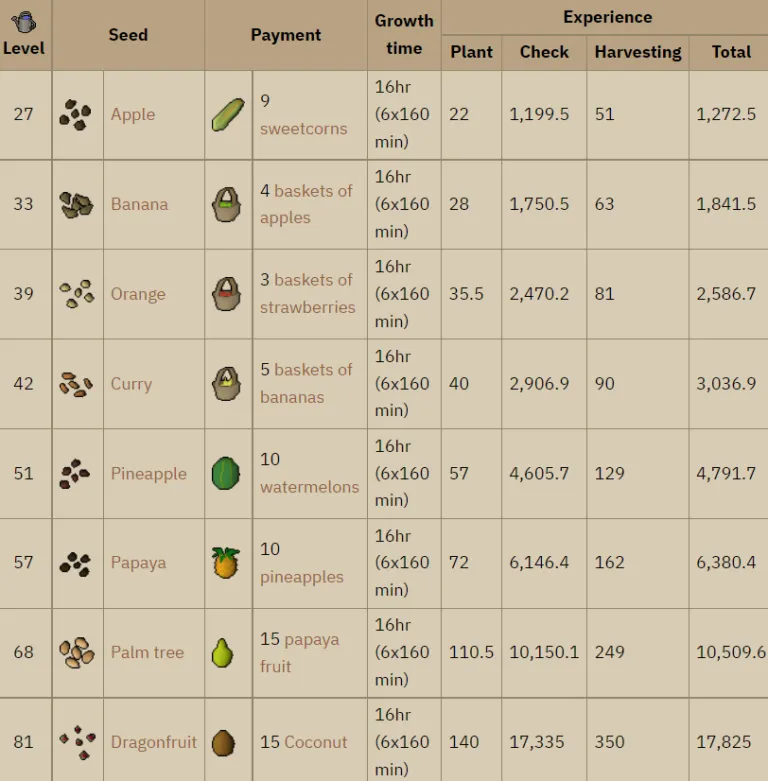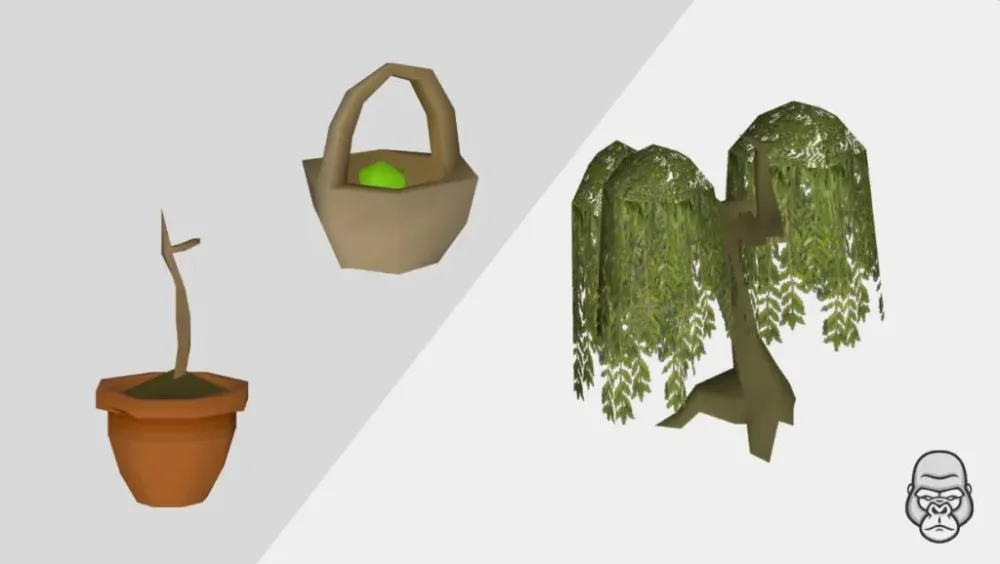Your cart is empty
OSRS Tree Growth Stages A Comprehensive Guide

Old School RuneScape (OSRS) Farming is a skill that rewards patience and planning, with tree growth being one of its most efficient training methods. Understanding tree growth stages in OSRS is key to maximizing experience points (XP) and managing resources effectively. This guide dives into the mechanics of tree growth, including regular trees, fruit trees, and special trees, offering practical tips to streamline your farming runs. Whether you’re a beginner or a seasoned farmer, this post will help you master tree growth stages for optimal results.
Tree farming involves planting seeds in tree patches scattered across Gielinor, nurturing them through growth stages, and checking their health for substantial Farming XP. Unlike other crops, trees don’t require constant attention, making them ideal for players who prefer passive training. The process includes preparing saplings, planting them, and monitoring their growth over several hours or days.
Why Tree Farming Matters
Tree runs are the backbone of Farming training due to their high XP yields in minimal active time. For example, a single tree run taking 5 minutes can yield 100,000 XP, effectively equating to 1,200,000 XP per hour if extrapolated over multiple runs. This efficiency makes tree farming essential for reaching level 99 Farming.
Types of Trees in OSRS
OSRS features three main tree categories, each with unique growth mechanics:
- Regular Trees: Oak, Willow, Maple, Yew, and Magic trees, grown in tree patches.
- Fruit Trees: Apple, Banana, Orange, Curry, Pineapple, Papaya, Palm, and Dragonfruit, grown in fruit tree patches.
- Special Trees: Calquat, Celastrus, Redwood, and Hardwood (Teak, Mahogany), grown in specific patches.
Tree Growth Stages Explained

Crops in OSRS, including trees, grow in discrete stages during specific time windows called growth ticks. Each tree type has a set number of stages and a defined growth cycle duration, which dictates how long it takes to reach full maturity. Growth only occurs during 5-minute growth stage windows, and the frequency depends on the tree type.
Regular Tree Growth Stages
Regular trees progress through 5 to 7 growth stages, depending on the tree type. Each stage advances every 40 minutes, with the total growth time ranging from 200 to 640 minutes. Here’s a breakdown:
| Tree Type | Farming Level | Growth Stages | Total Growth Time | XP (Check Health) |
|---|---|---|---|---|
| Oak | 15 | 5 | 200 minutes (3h 20m) | 467.3 |
| Willow | 30 | 6 | 280 minutes (4h 40m) | 1,456.5 |
| Maple | 45 | 6 | 320 minutes (5h 20m) | 3,403.4 |
| Yew | 60 | 7 | 400 minutes (6h 40m) | 7,069.9 |
| Magic | 75 | 7 | 480 minutes (8h) | 13,768.3 |
Fruit Tree Growth Stages
Fruit trees have 6 growth stages, each lasting 160 minutes, totaling 960 minutes (16 hours). They require an intermediate sapling stage before planting. Once fully grown, they yield 6 fruits, regenerating one every 40 minutes.
| Fruit Tree | Farming Level | Total Growth Time | XP (Check Health) | Protection Payment |
|---|---|---|---|---|
| Apple | 27 | 960 minutes (16h) | 1,199.5 | 9 Sweetcorn |
| Banana | 33 | 960 minutes (16h) | 1,750.5 | 4 Baskets of Apples |
| Palm | 68 | 960 minutes (16h) | 10,150.1 | 15 Papayas |
| Dragonfruit | 81 | 960 minutes (16h) | 17,335 | 15 Coconuts |
Special Tree Growth Stages
Special trees like Calquat, Celastrus, and Redwood have unique growth patterns:
- Calquat: 8 stages, 160 minutes each, totaling 1,280 minutes (21h 20m). Yields 12,096 XP.
- Celastrus: 5 stages, 160 minutes each, totaling 800 minutes (13h 20m). Yields 14,130 XP.
- Redwood: 11 stages, 640 minutes each, totaling 7,040 minutes (117h 20m or ~4.9 days). Yields 22,450 XP.
- Hardwood (Teak/Mahogany): 8 stages, 320 minutes each, totaling 2,560 minutes (42h 40m). Teak yields 7,290 XP; Mahogany yields 15,720 XP.
How to Prepare and Plant Trees

Planting trees follows a specific process to ensure healthy growth and maximum XP. Here’s a step-by-step guide:
Creating a Sapling
- Fill a Plant Pot: Use an empty plant pot on a farming patch with a gardening trowel to fill it with soil.
- Plant the Seed: Add a tree or fruit tree seed to the filled pot and water it with a watering can.
- Wait for Growth: After a few minutes, the seedling grows into a sapling, ready for planting.
Planting and Protecting Trees
Once you have a sapling, head to a tree patch. Clear weeds with a rake, plant the sapling with a spade, and apply compost (supercompost or ultracompost) to reduce disease risk. Alternatively, pay a nearby farmer to protect the tree, eliminating disease entirely. For example, paying 200 coins to remove a tree or items like 15 papayas for a palm tree ensures healthy growth.
Managing Growth and Disease
Trees can become diseased during growth stages, halting progress until cured. Understanding disease mechanics and growth timing is crucial.
Disease Prevention and Cure
To minimize disease:
- Use Compost: Ultracompost reduces disease risk significantly and increases yield for some crops.
- Pay Farmers: Paying for protection guarantees no disease, ideal for expensive trees like Magic or Palm.
- Prune Diseased Trees: Use secateurs or magic secateurs to remove diseased leaves, restoring health.
- Falador Elite Diary: Completing this makes the Falador tree patch disease-free.
If a tree becomes diseased, it repeats the current growth stage, delaying growth. For fruit trees, even protected trees may repeat a stage if diseased, though this is rare.
Growth Tick Mechanics
Growth ticks occur every 5 minutes, but trees only advance during their specific growth windows (e.g., every 40 minutes for regular trees, 160 minutes for fruit trees). Logging in or out resets your growth tick timer, potentially delaying growth if you miss a window. Planting just before a growth tick can shorten the first stage significantly.
Tips for Efficient Tree Runs
Optimizing tree runs saves time and maximizes XP. Here are practical tips to enhance your farming efficiency:
Plan Your Route
Visit patches in a logical order based on teleport availability. Recommended teleports include:
- Spirit Tree: Gnome Stronghold (requires Tree Gnome Village quest).
- Slayer Ring: Stronghold Slayer Cave for the Gnome Stronghold patch.
- Teleport Crystals: Lletya fruit tree patch (start Mourning’s End Part I).
- Scrolls of Redirection: Teleport to house portals near patches (Nightmare Zone reward).
Use High-Level Trees
Plant the highest-level trees your Farming level allows for maximum XP. For example, at level 75, prioritize Magic trees and Palm trees over lower-tier options.
Leverage Rapid Growth Spell
The Rapid Growth spell (unlocked via The Light Within in RS3, not available in OSRS) isn’t an option, but in OSRS, consider using the Kronos seed to skip growth stages globally. This requires 76 Farming and can save hours.
Track Growth with Tools
Use the RuneLite client’s Farming plugin to monitor growth stages and avoid checking patches prematurely. This is especially useful for fruit trees, which may appear “done” but need extra time.
Conclusion
Mastering OSRS tree growth stages is essential for efficient Farming training. By understanding growth mechanics, preparing saplings correctly, preventing disease, and optimizing your tree runs, you can achieve rapid XP gains with minimal effort. Start with Oak and Apple trees at lower levels, progress to Magic and Palm trees, and incorporate special trees like Redwood for high-level training. With careful planning and the right teleports, your journey to 99 Farming will be both rewarding and profitable.

